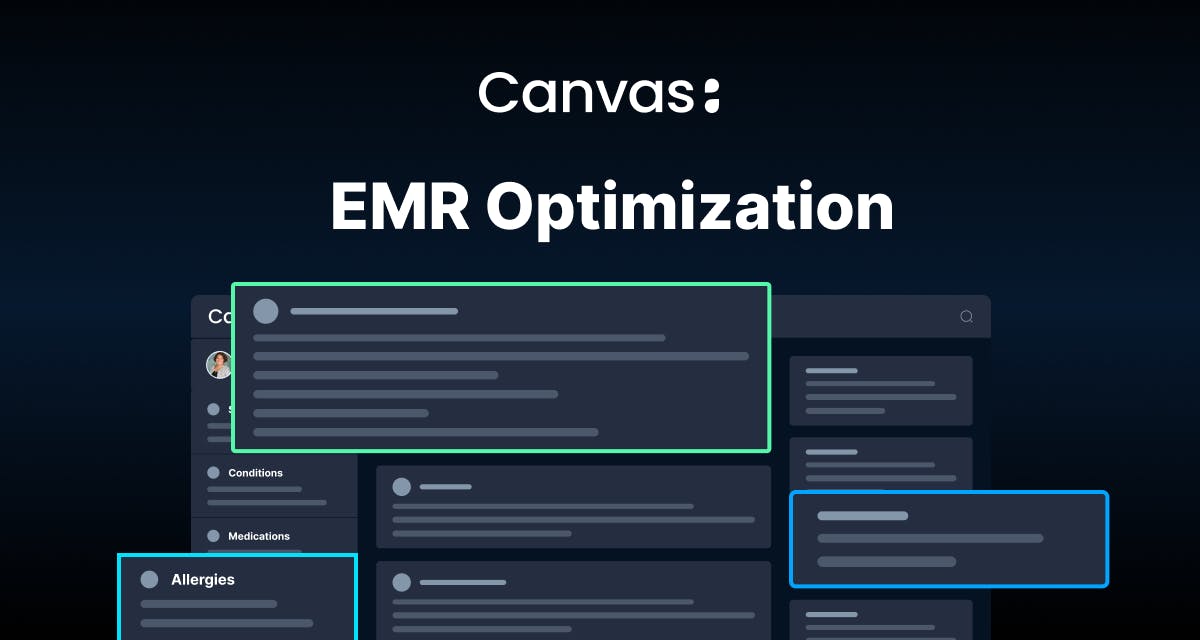Electronic medical records (EMR) systems are essential to modern healthcare organizations. Effective EMR deployment and ongoing optimization of an EMR transforms how information flows between care teams and patients. When an EMR system is effective, it returns clinician focus to the patient relationship, reduces administrative costs of running a healthcare practice, and improves health outcomes across a patient population.
Yet many healthcare clinicians still face challenges with their current EMR, from complex interfaces and manual processes to inconsistent documentation quality. These issues not only frustrate staff but can also compromise the safety of the patient and slow down care delivery.
The solution lies in the iterative process of improvement. At Canvas Medical, we call this process care modeling but it is often called EMR optimization. Through extending and customizing the EMR system over time, a clinical organization can reduce administrative burden, improve clinical workflows, and strengthen care coordination across multiple clinicians.
Understanding Electronic Medical Records
Electronic medical records (EMRs) are the backbone of modern healthcare. An electronic medical record system securely stores patient health information, diagnoses, lab results, imaging, prescriptions, and treatment plans—all in one place.
Think of it as a compliant, centralized database that provides authorized clinicians and clinical staff with instant access to the information needed to care for a patient. EMR systems go beyond the four walls of the clinic to support coordination across the care team, enabling smoother communication and comprehensive patient-centered care.
Key features often found in electronic health records include:
- Appointment scheduling and resource management
- E-prescriptions with safety checks for drug interactions
- Automated lab and imaging result integration
- Billing, reporting, and claims management modules
- Secure documentation and storage compliant with HIPAA-compliance standards
When implemented, these features reduce errors, improve documentation quality, and support safer, more efficient care.
Goals of EMR Optimization
EMR optimization can maximize the return on investment from an EMR system. This discipline focuses on aligning the system with clinical and operational needs.
- Improve Documentation Quality - Accurate and standardized documentation is the foundation of safe and effective care. Optimized EMRs include templates, ambient scribe, and decision-support tools that improve efficiency while reducing errors.
- Reduce Administrative Burden - Physicians and nurses often spend hours on charting and EMR workflows. Optimization strategies like tasking automation and role-based workflows can drastically reduce this time when leveraging a more modern software interface, reducing time spent on repetitive tasks.
- Enhance Care Coordination - Integrated systems ensure that information flows smoothly between clinicians inside and outside of the practice. Care teams are increasingly multi-modal and multi-disciplinary, which increases the important of a system with an up-to-date approach to interoperability and support for the latest data integration standards. This reduces duplicate testing, supports clinicians' work, and helps patients avoid dangerous gaps in their known history.
- Increase Operational Efficiency - Any well-designed EMR can automate repetitive tasks to reduce double documentation, improve coding accuracy, generate standing orders and care plans. Benefits span every clinical, financial and operational workflow from effective scheduling and resource optimization through to improving percent of touchless claims to improve operating cash flow.
- Support Ongoing Adoption - In a programmable EMR like Canvas, there is a beneficial loop between adoption and optimization, as user behaviors and feedback make their way into the user experience to improve automation and usability. This process of iteration to drive adoption and increased value is an important part of effective EMR optimization.
Improving Clinical Workflows in EMR Systems
The clinical workflow is at the core of upstream and downstream improvements to the patient experience and clinical operations. Common strategies include:
- Mapping workflows: Reviewing the sequential steps for the various clinical scenarios faced in the practice to identify opportunities for improved usability and increased automation.
- Automating care plan and task creation: Appointment reminders, prescription renewals, and insurance checks are all easy wins for time savings and improved data quality.
- Template standardization: Custom templates for common visit types and scenarios can drive documentation quality and while reducing screen time.
- Role-based workflows: Ensure each staff member sees only the relevant data and the right sub-set of tasks improves usability and operating efficiency.
Example: In a diabetes management program, standardized templates and lab integration ensure consistent monitoring of A1C, blood pressure, and referrals to specialists for required exams—while automation flags missed care steps for follow-up.
Ensuring Data Quality and Access
EMR optimization reduces documentation error and improves data quality by:
- Using structured forms instead of free-text fields
- Applying auto-complete and drop-down menus for consistency
- Implementing intelligent alerts for critical issues like allergies or drug interactions
- Reducing manual data pulls or double documentation through automation
Quick, reliable access to patient data is central to quality care. Optimized EMRs provide:
- Advanced search tools to locate patients by diagnosis, medication, or history
- Mobile access so clinicians can securely review records during rounds or after hours
- Data visualization tools, like trend graphs and dashboards, to support faster decisions
- Communication features, such as secure messaging, are used to enhance engagement with patients
Patients also benefit directly. Modern portals give them 24/7 access to their records, test results, and treatment plans, improving transparency and satisfaction.
Reliable and Performant Architecture
An optimized EMR must perform reliably under real-world clinical demands. Key architectural priorities include:
- Speed and responsiveness: Patient records, lab results, and medication lists must load instantly to keep appointments on schedule and enable rapid clinical decisions.
- System reliability: The EMR must maintain consistent uptime with minimal service interruptions, ensuring clinicians can access critical information when needed.
- Scalability: The system must maintain performance as patient volumes grow, handling increased data loads without degradation.
- Efficient data architecture: Smart database design—including optimized queries, strategic caching of frequently accessed records, and intelligent data partitioning—ensures fast retrieval even as datasets expand.
- Clinical intelligence: Real-time decision support and predictive analytics must operate without slowing down core workflows, providing insights at the point of care.
These architectural foundations reduce appointment delays, minimize provider frustration, and enable efficient care delivery across all departments.
Maintenance and Iteration on EMR Optimization
EMR optimization is an ongoing process, and should retain a consistent operational focus. It requires ongoing assessment, continuous staff education, and the right technology partner. Practices that commit to this mindset see measurable improvements across their operations.
Optimization strengthens care coordination between teams, eases the administrative burden on staff, and improves both documentation and reporting accuracy. It also drives greater operational efficiency, reduces costs, and contributes to stronger safeguards for patient safety.
Strategies include:
- Role-based training so each user learns the tools they need
- Designating internal EMR champions to support peers and encourage adoption
- Engaging subject matter experts to evaluate and improve on workflows
- Surveying for feedback regularly to identify usability challenges
- Providing resources like cheat sheets, workflow diagrams, and training videos
This ongoing process builds confidence, strengthens usability, and ensures optimization efforts stick.
Canvas supports training with intuitive design, documentation, and an ecosystem of partners who guide implementation and education.
How Canvas Medical Delivers EMR Optimization
Canvas Medical’s programmable EMR, developer tools, and unified data architecture allow organizations to integrate, automate, and customize workflows within one unified platform. Built on a certified EMR foundation with extensive support for modern data standards, Canvas seamlessly connects clinical, operational, and financial data to eliminate silos.
Through its software development kit (SDK) and FHIR-based APIs, organizations tailor workflows, build custom extensions, and integrate third-party applications that fit their specific needs. This flexibility allows healthcare teams to automate key processes while maintaining compliance and accuracy across systems.
Canvas supports event-driven automation, where events or data such as new lab results, medication changes, or patient communications can automatically trigger effects to generate follow-up or next steps. This reduces administrative burden, minimizes delays, and ensures that every step of the care journey stays connected.
With real-time FHIR data exchange, Canvas improves coordination between clinicians, payers, and ancillary systems, supporting faster decisions and more reliable billing. Built-in analytics and visualization tools help organizations monitor efficiency, identify workflow bottlenecks, and continuously enhance performance.
Designed with usability in mind, Canvas provides a clean, role-based interface that aligns with each team member’s workflow—from clinicians to administrators. The result is an EMR that adapts to how care teams work, not the other way around.
Ready to unlock the full potential of EMR optimization? Discover how Canvas can help your practice improve efficiency, streamline clinical workflows, and deliver better outcomes.
Frequently Asked Questions (FAQs)
What is EMR optimization?
EMR optimization is the process of enhancing how an electronic medical records (EMR) system is utilized to better support clinical workflows, reduce administrative burden, and improve patient outcomes. It often involves customizing features, streamlining documentation, improving usability, and integrating automation.
Why is EMR optimization important for healthcare clinicians?
Optimization helps clinicians save time, reduce errors, and ensure access to up-to-date information across the care team. It also improves billing accuracy, strengthens care coordination, and increases operational efficiency, leading to better overall patient care and smoother practice management.
How can EMR optimization reduce clinician burnout?
By streamlining documentation and automating repetitive tasks, EMR optimization gives clinicians more time to focus on patient interaction instead of screens. This reduction in administrative burden eases stress, improves job satisfaction, and supports long-term retention of healthcare staff.
What steps are involved in successful EMR optimization?
Successful optimization includes assessing current workflows, addressing usability issues, providing role-based training, and involving EMR champions or subject matter experts for ongoing feedback. Continuous monitoring and refinement ensure the system adapts to evolving clinical and operational needs.

